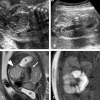The usefulness of fetal MRI for prenatal diagnosis
- PMID: 17722241
- PMCID: PMC2628062
- DOI: 10.3349/ymj.2007.48.4.671
The usefulness of fetal MRI for prenatal diagnosis
Abstract
Purpose: Fast MRI has provided detailed and reproducible fetal anatomy. This study was performed to evaluate the usefulness of fetal MRI for prenatal diagnosis.
Materials and methods: Fifty-six fetuses with congenital abnormalities on ultrasonography were evaluated by fetal MRI from 2001 to 2004 in Severance Hospital. Final diagnosis was made by postnatal pathology, postnatal MRI, and other modalities (such as ultrasound, retrograde pyelogram). A 1.5-Tesla superconductive MR imaging unit was used to obtain half-Fourier acquisition single-shot turbo spin images.
Results: Of the 56 fetuses, intracranial abnormalities were found in 26 fetuses, intraabdominal abnormalities in 17 fetuses, intrathoracic in 6 fetuses, head and neck in 5 fetuses, and other sites in 2 fetuses. There were six cases in which the diagnoses of fetal MRI and ultrasonography differed. In such cases, fetal MRI provided more exact diagnosis than ultrasonography (5 vs. 0). Three fetuses with intracranial abnormalities on ultrasonography were diagnosed as normal by fetal MRI and in postnatal diagnosis.
Conclusion: Although ultrasonography is known as a screening modality of choice in the evaluation of fetus because of the cost-effectiveness and safety, the sonographic findings are occasionally inconclusive or insufficient for choosing the proper management. Thus, in this study, we suggest that fetal MRI is more useful than ultrasonography for the evaluation of intracranial abnormalities in some instances. For prenatal counseling and postnatal treatment planning, fetal MRI can be informative when prenatal ultrasonography is inadequate and doubtful.
Figures




Similar articles
-
Magnetic resonance imaging of fetuses with intracranial defects.Obstet Gynecol. 1991 Apr;77(4):529-32. Obstet Gynecol. 1991. PMID: 2002974
-
The value of fast MR imaging as an adjunct to ultrasound in prenatal diagnosis.Eur Radiol. 2003 Jul;13(7):1538-48. doi: 10.1007/s00330-002-1811-6. Epub 2003 Apr 15. Eur Radiol. 2003. PMID: 12695920
-
Cytomegalovirus-related fetal brain lesions: comparison between targeted ultrasound examination and magnetic resonance imaging.Ultrasound Obstet Gynecol. 2008 Dec;32(7):900-5. doi: 10.1002/uog.6129. Ultrasound Obstet Gynecol. 2008. PMID: 18991327
-
Ultrasound versus magnetic resonance imaging in fetal evaluation.Top Magn Reson Imaging. 2001 Feb;12(1):25-38. doi: 10.1097/00002142-200102000-00004. Top Magn Reson Imaging. 2001. PMID: 11215713 Review.
-
Prenatal imaging - role of fetal MRI.Rofo. 2025 Apr;197(4):385-396. doi: 10.1055/a-2357-6997. Epub 2024 Dec 6. Rofo. 2025. PMID: 39642925 Review. English, German.
Cited by
-
The fetal magnetic resonance imaging experience in a large community medical center.J Clin Imaging Sci. 2011;1:29. doi: 10.4103/2156-7514.81772. Epub 2011 May 31. J Clin Imaging Sci. 2011. PMID: 21966626 Free PMC article.
-
Fetal Magnetic Resonance Imaging of Malformations Associated with Heterotaxy.Cureus. 2015 May 21;7(5):e269. doi: 10.7759/cureus.269. eCollection 2015 May. Cureus. 2015. PMID: 26180693 Free PMC article. Review.
-
Measuring intrauterine growth in healthy pregnancies using quantitative magnetic resonance imaging.J Perinatol. 2022 Jul;42(7):860-865. doi: 10.1038/s41372-022-01340-6. Epub 2022 Feb 23. J Perinatol. 2022. PMID: 35194161 Free PMC article.
-
Trends in prenatal diagnosis of congenital anomalies in Western Australia between 1980 and 2020: A population-based study.Paediatr Perinat Epidemiol. 2023 Sep;37(7):596-606. doi: 10.1111/ppe.12983. Epub 2023 May 4. Paediatr Perinat Epidemiol. 2023. PMID: 37143205 Free PMC article.
-
Congenital anomalies of the kidney and urinary tract: antenatal diagnosis, management and counselling of families.Pediatr Nephrol. 2024 Apr;39(4):1065-1075. doi: 10.1007/s00467-023-06137-z. Epub 2023 Sep 1. Pediatr Nephrol. 2024. PMID: 37656310 Free PMC article.
References
-
- Garel C, Brisse H, Sebag G, Elmaleh M, Oury JF, Hassan M. Magnetic resonance imaging of the fetus. Pediatr Radiol. 1998;28:201–211. - PubMed
-
- Angtuaco TL, Shah HR, Mattison DR, Quirk JG. MR imaging in high-risk obstetric patients: a valuable complement to US. Radiographics. 1992;12:91–110. - PubMed
-
- Sonigo PC, Rypens FF, Carteret M, Delezoide AL, Brunelle FO. MR imaging of fetal cerebral anomalies. Pediatr Radiol. 1998;28:212–222. - PubMed
-
- Smith FW, Adam AH, Phillips WD. NMR imaging in pregnancy. Lancet. 1983;1:61–62. - PubMed
-
- Stark DD, McCarthy SM, Filly RA, Parer JT, Hricak H, Callen PW. Pelvimetry by magnetic resonance imaging. AJR Am J Roentgenol. 1985;144:947–950. - PubMed
Publication types
MeSH terms
LinkOut - more resources
Full Text Sources
Medical

